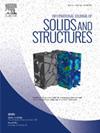一维线性弹性动力学的适定非局部理论
IF 3.4
3区 工程技术
Q1 MECHANICS
International Journal of Solids and Structures
Pub Date : 2025-06-23
DOI:10.1016/j.ijsolstr.2025.113511
引用次数: 0
摘要
我们展示了如何用核修正构造一个纯非局部弹性的适定理论。具体地说,我们修改了经典亥姆霍兹核,使与其相关的本构边界条件被从手头问题的自然边界条件中产生的约束所取代。通过两个例子说明了该方法,一个是处理静定问题,另一个是处理悬臂梁的自由振动问题。该方法的定义特征是修改后的核不再是差分核。这个结果是问题的边界条件合并的结果,它影响边界附近的核,因此,诱导不同的机械响应依赖于与这些距离的关系。相比之下,材料内部的变化可以忽略不计。修正核仍然是对称的和正定的,这一性质保证了应变能是二次的和正定的,并且它符合冲动性的要求,使它在一个消失的非局部长度尺度的极限下恢复到经典局部理论。在许多方面,核修正在概念上与两阶段方法不同,最显著的原因是,除了与问题的物理性质自然相关的边界条件外,它不需要引入额外的边界条件。本文章由计算机程序翻译,如有差异,请以英文原文为准。
A well-posed non-local theory in 1D linear elastodynamics
We show how to construct a well-posed theory of purely non-local elasticity by kernel modification. Specifically, we modify the classical Helmholtz kernel so that the constitutive boundary conditions associated with it are replaced by constraints that emerge from the natural boundary conditions of the problem at hand. The procedure is illustrated by two examples, one dealing with a statically indeterminate problem and the other concerning free vibrations of a cantilever beam. The defining feature of the method is that the modified kernel is no longer a difference kernel. This outcome is a consequence of the incorporation of the problem’s boundary conditions, which affects the kernel near the boundaries and, consequently, induces a different mechanical response in dependence of the distance from those. In contrast, negligible changes are found in the interior of the material. Still, the modified kernel remains symmetric and positive definite, which property guarantees that the strain energy is quadratic and positive definite, and it complies with the impulsivity requirement, by which it reverts to the classical local theory in the limit of a vanishing non-local length-scale. Kernel modification is conceptually different from the two-phase approach under many respects, most notably because it gets away from the need to introduce extra boundary conditions besides those naturally associated with the physics of the problem.
求助全文
通过发布文献求助,成功后即可免费获取论文全文。
去求助
来源期刊
CiteScore
6.70
自引率
8.30%
发文量
405
审稿时长
70 days
期刊介绍:
The International Journal of Solids and Structures has as its objective the publication and dissemination of original research in Mechanics of Solids and Structures as a field of Applied Science and Engineering. It fosters thus the exchange of ideas among workers in different parts of the world and also among workers who emphasize different aspects of the foundations and applications of the field.
Standing as it does at the cross-roads of Materials Science, Life Sciences, Mathematics, Physics and Engineering Design, the Mechanics of Solids and Structures is experiencing considerable growth as a result of recent technological advances. The Journal, by providing an international medium of communication, is encouraging this growth and is encompassing all aspects of the field from the more classical problems of structural analysis to mechanics of solids continually interacting with other media and including fracture, flow, wave propagation, heat transfer, thermal effects in solids, optimum design methods, model analysis, structural topology and numerical techniques. Interest extends to both inorganic and organic solids and structures.

 求助内容:
求助内容: 应助结果提醒方式:
应助结果提醒方式:


